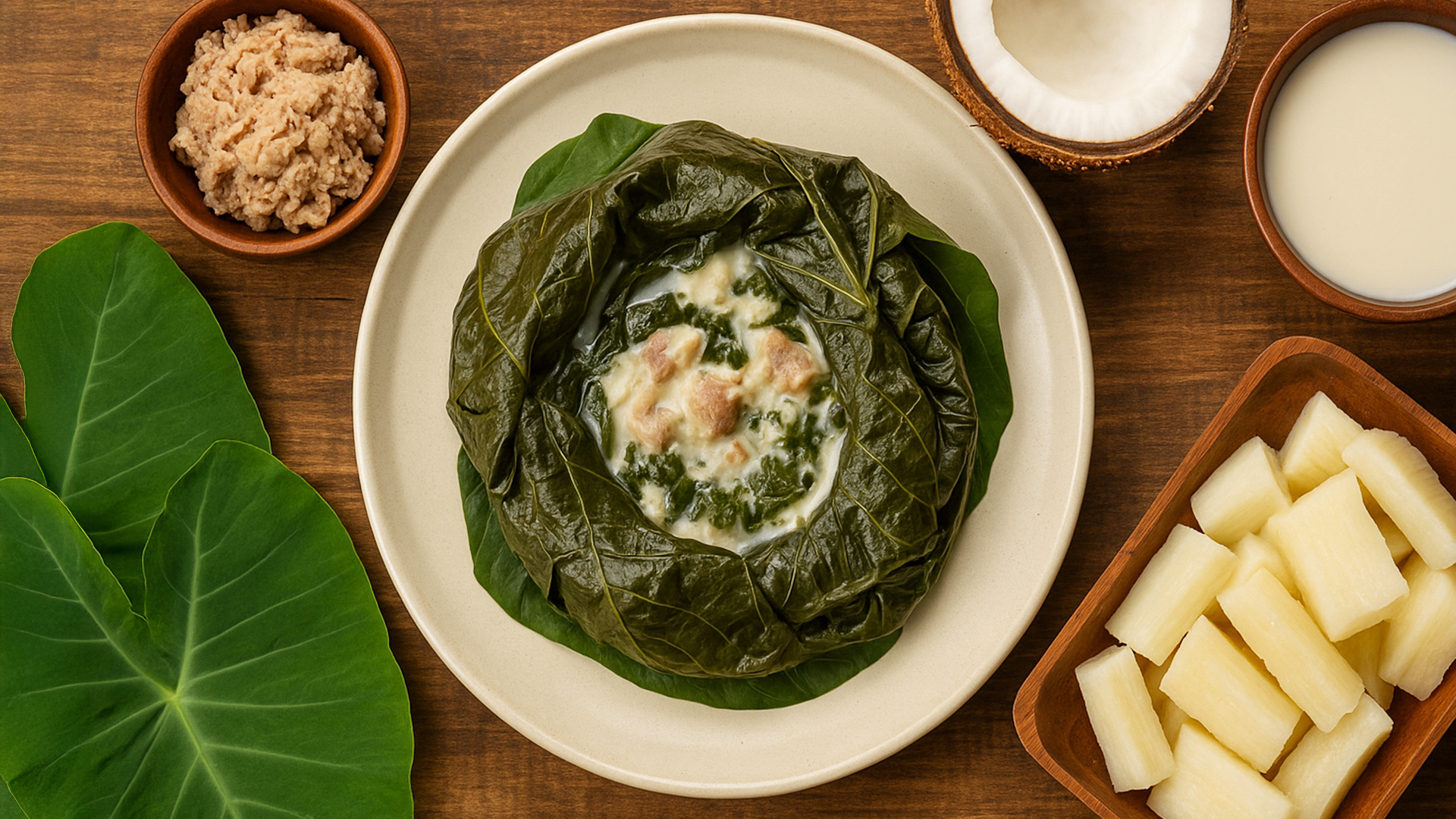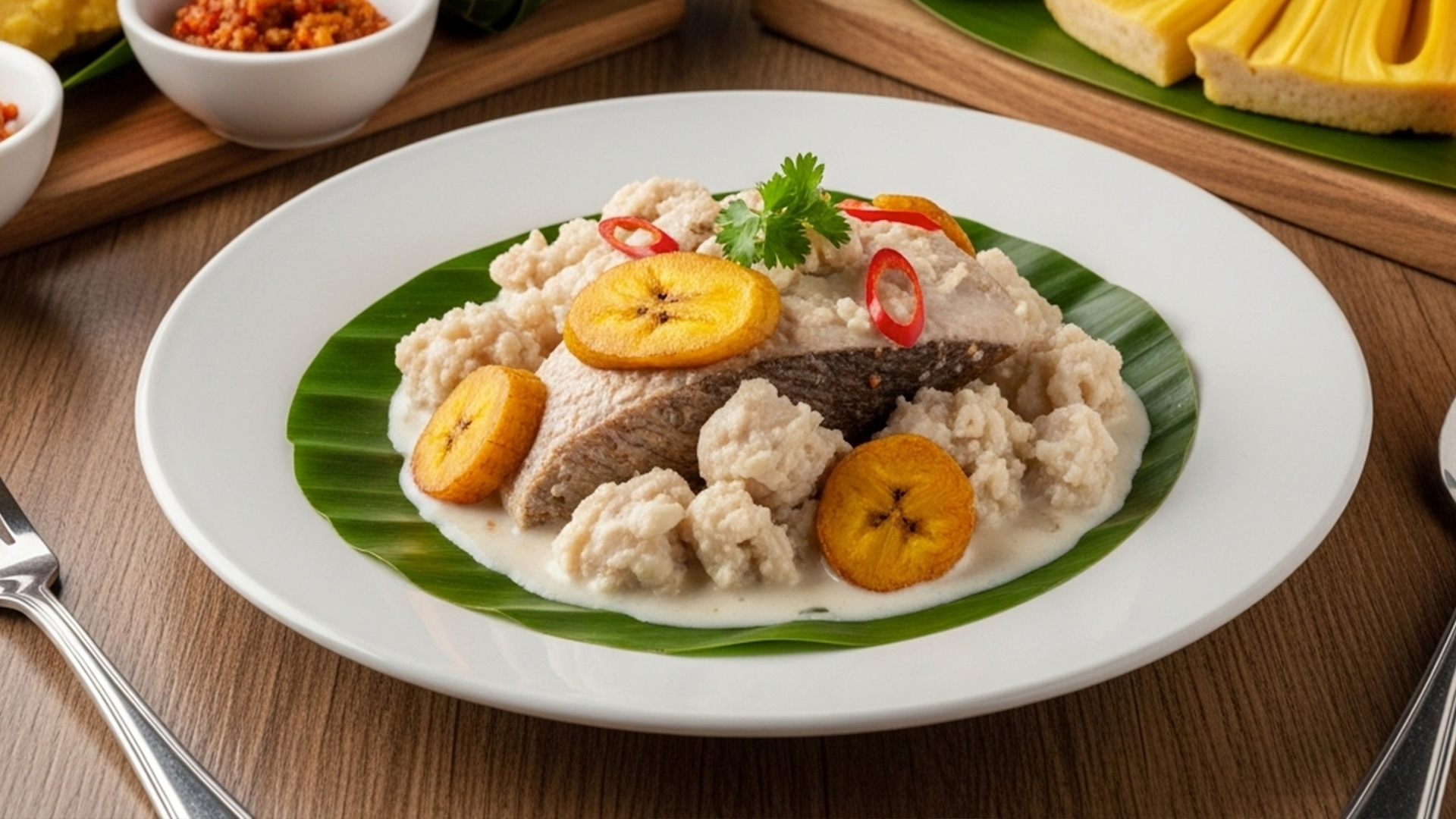Palusami, the most popular comfort food in Kiribati and the centerpiece of any traditional feast, is savory, creamy, and encased in island charm. This oven-steamed parcel, which is made with tender taro leaves that have been lovingly filled with rich coconut cream, chopped onions, and occasionally salted meat or fish, explodes with tropical flavor with each bite. Its earthy sweetness and smooth texture capture the essence of Pacific island cooking, which is wholesome, straightforward, and firmly anchored in the land and sea. Wrapped in green and dripping with coconut gold, palusami is a taste of Kiribati's soul that can be enjoyed at a botaki (feast) or during a family meal. Read More...
The History of Kiribati’s National Dish: Palusami:
On the remote coral atolls and sun-soaked islands of Kiribati, a dish both humble and heavenly holds a special place in the hearts of its people: Palusami. This creamy, coconut-rich delicacy wrapped in taro leaves is more than just food—it is a symbol of island life, cultural pride, and community spirit. Rooted in centuries of tradition and shared across many Pacific nations, Palusami stands as a culinary expression of resourcefulness, simplicity, and celebration.
Island Origins and Regional Ties:
Palusami’s origins are woven into the shared culinary heritage of Polynesia, Micronesia, and Melanesia. It is particularly beloved in countries like Samoa, Fiji, Tonga, and of course, Kiribati, where it has become an essential part of local feasts and daily meals. The name “Palusami” itself is most commonly associated with Samoan tradition, but its preparation in Kiribati has taken on a unique, localized character based on the ingredients available and cultural context.
In a land where agricultural space is limited and the environment is shaped by the sea, Kiribati cuisine relies heavily on local crops like taro, pandanus, breadfruit, and coconut, alongside preserved meats and seafood. Palusami makes ingenious use of what is most abundant: taro leaves and coconut cream. These two ingredients form the base of a dish that is flavorful, filling, and flexible—able to incorporate corned beef, fresh fish, or stay vegetarian.
The Heart of the Dish – Coconut and Taro:
Coconut is a lifeline in Kiribati—used for food, drink, fuel, building materials, and more. In Palusami, thick coconut cream brings a rich, slightly sweet flavor and velvety texture that melts into the taro leaves as they steam. The leaves, which come from the taro plant, are naturally earthy and soft when cooked, wrapping the coconut mixture like a leafy envelope.
In pre-colonial times, Palusami and similar dishes were cooked using earth ovens (called umai in Kiribati), where the wrapped leaf parcels were placed in hot stones and buried to cook slowly. This traditional method infuses the dish with a subtle smokiness and deep, slow-cooked flavor. Today, many families prepare Palusami in modern ovens or steamers, but the spirit of the dish remains the same.
Palusami and Kiribati Culture:
Palusami plays a starring role in botaki—traditional feasts held for weddings, funerals, elder birthdays, and communal events. In these settings, food is not just nourishment but a gift, a gesture of love, and a means of bringing people together. Palusami is often prepared in large quantities, each parcel lovingly wrapped and presented alongside seafood, rice, and breadfruit.
Because of its simplicity and adaptability, Palusami is also a popular home-cooked dish, bridging the gap between everyday meals and ceremonial cuisine. It reflects the collective values of Kiribati culture: sharing, family, resilience, and gratitude.
Sustaining Tradition in a Changing World:
Like many Pacific nations, Kiribati faces the pressures of climate change, imported food systems, and modernization. As imported foods become more accessible, traditional dishes like Palusami are treasured even more as symbols of cultural preservation and identity. Local leaders and community members continue to promote traditional cooking to keep island food knowledge alive for future generations.
In this way, Palusami is more than a dish—it is a link to the past, a celebration of the present, and a taste of resilience for the future.
Whether served on a palm-lined beach or from a humble home kitchen, Palusami captures the essence of Kiribati: simple, strong, and full of warmth. It is a dish wrapped not just in taro leaves, but in memory, meaning, and a taste of home.
Prepare the Leaves:

Make the Filling:
Wrap the Palusami Parcels:

Cook the Palusami:
Option A – Bake:
Option B – Steam:
Serve:

Tips:
The total preparation and cooking time for Palusami is approximately 1 hour to 1 hour and 15 minutes. Prepping the taro leaves (including washing, trimming, and optional blanching) and mixing the coconut filling takes about 20–25 minutes. Wrapping the parcels in leaves and foil takes an additional 10–15 minutes, depending on how many you're making. Cooking time—whether baked or steamed—averages 40–45 minutes, allowing the leaves to become tender and the coconut filling to meld with the other flavors. While the process is simple, the dish benefits from patient cooking to develop its full, rich taste.
A single serving of Palusami, based on the traditional recipe provided, contains approximately 300–450 calories, depending on portion size and optional ingredients used. The coconut cream is the most calorie-dense component, contributing about 200–250 calories per serving due to its high fat content. Taro leaves are low in calories, adding around 20–40 calories, while the onion and basic seasonings contribute minimally. If corned beef or canned tuna is included, it can add an additional 80–150 calories per serving. Overall, Palusami is a rich, satisfying dish that balances flavor and energy in a relatively small portion.







